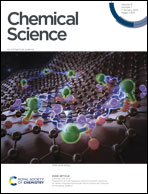Photocatalytic ethane conversion on rutile TiO2(110): identifying the role of the ethyl radical†
Abstract
Oxidative dehydrogenation of ethane (C2H6, ODHE) is a promising approach to producing ethene (C2H4) in the chemical industry. However, the ODHE needs to be operated at a high temperature, and realizing the ODHE under mild conditions is still a big challenge. Herein, using photocatalytic ODHE to obtain C2H4 has been achieved successfully on a model rutile(R)-TiO2(110) surface with high selectivity. Initially, the C2H6 reacts with hole trapped OTi− centers to produce ethyl radicals  , which can be precisely detected by a sensitive TOF method, and then the majority of the
, which can be precisely detected by a sensitive TOF method, and then the majority of the  radicals spontaneously dehydrogenate into C2H4 without another photo-generated hole. In addition, parts of the
radicals spontaneously dehydrogenate into C2H4 without another photo-generated hole. In addition, parts of the  radicals rebound with diversified surface sites to produce C2 products via migration along the surface. The mechanistic model built in this work not only advances our knowledge of the C–H bond activation and low temperature C2H6 conversion, but also provides new opportunities for realizing the ODHE with high C2H4 efficiency under mild conditions.
radicals rebound with diversified surface sites to produce C2 products via migration along the surface. The mechanistic model built in this work not only advances our knowledge of the C–H bond activation and low temperature C2H6 conversion, but also provides new opportunities for realizing the ODHE with high C2H4 efficiency under mild conditions.



 Please wait while we load your content...
Please wait while we load your content...